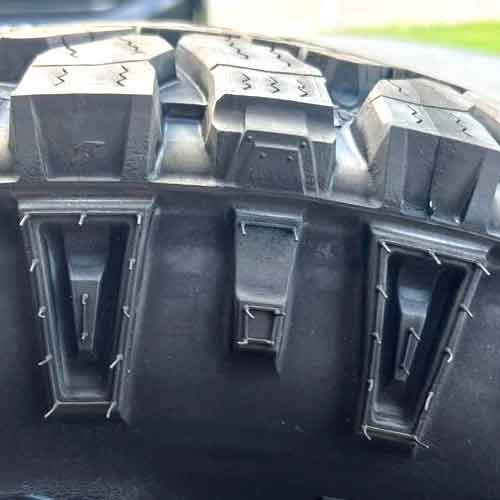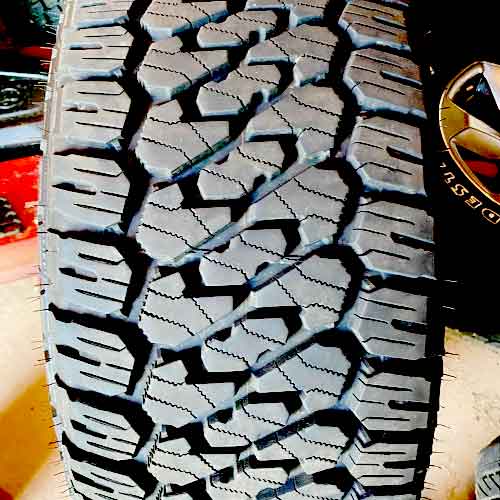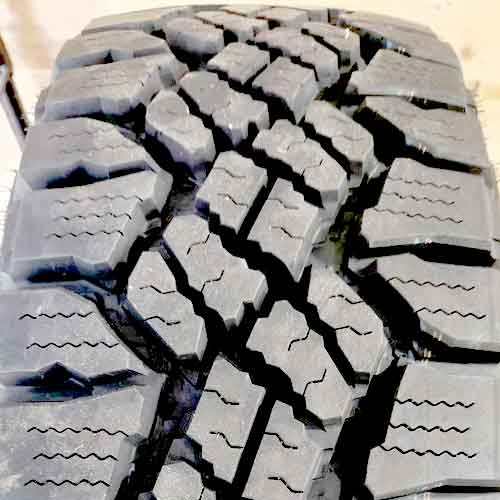Both the Firestone Destination X/T and the good old Goodyear Duratrac are although marketed as all-terrain tires, their tread tell a different story. Out of them, the Destination X/T comes in aggressive A/T category, whereas the Duratrac has a hybrid design, so it’s from rugged-terrain. Though you’ll be surprised by both of their on/off road capabilities. Let’s check them out!

As a tire engineer, I believe that the Firestone Destination X/T is a true all-terrain tire that offers excellent performance on and off the road. Its wet traction on the road is particularly impressive, making it a standout feature of the tire. Off-road, the tire provides good durability and has aggressive shoulder lugs with the deepest tread in its category. In contrast, the Goodyear Wrangler Duratrac may not perform as well on the road, but it offers better stability on rugged terrains and can handle a bit of mud. It also performs well in the snow and has a 3 peak mountain snowflake rating, similar to the Firestone Destination X/T.
(Highlighted links above contain their detailed review, it’s recommended you check them out first, for better understanding).
Sizes
Goodyear Wrangler Duratrac offers 15 to 22″ rim sizes which have:
- 3PMSF and M+S ratings available on all sizes.
- 16 Stud-able lugs (only on LT sizes, though).
- Weight range: 35 to 68 lbs.
- Load rating goes up to F.
- Speed rating: Q, S, P, and T.
- Tread depth: 16/32″ to 18/32″.
- Warranty of 50k miles but only for LT sizes.
Learn speed rating: https://tiredriver.com/speed-rating-on-tires/
Learn load rating: https://tiredriver.com/load-index-range-and-ply-rating/
On the other side Firestone Destination X/T comes in 15 to 20 inches with following features.
- 3PMSF and M+S ratings are available on all sizes.
- 50,000 mile tread life warranty for all sizes.
- Speed ratings stay in R and S.
- Load ratings: C and E only.
- Weight range: 35 to 60 lbs.
- Tread depth comes in 14 to 17/32″.
Also Note: On all sizes, both tires feature 2 ply polyester casing, 2 steel belts and 2 cap plies of nylon, so you can say they are equally durable.
Tread Appearance
The Firestone Destination X/T has two distinctive ribs in the middle section .

The central most ribs are S shaped, they are smaller then the surrounding.
While the wrapped lugs on sides, are kind of “U” shaped, and besides being thicker, they also carry more biter in the form of zigzag teeth (placed on the outer edges).
All these lugs carry wave-like full depth siping and are prominently divided by wide longitudinal grooves, separating aside the shoulder lugs.
The shoulder lugs are very block like, they also carry full depth siping, though they don’t have as much of an interlocking design.
Towards outer margins, they are staggered and make full depth slits (which are basically designed to provide ample snow traction).
That’s why its 3 peak snowflake rated, just like it’s competitor.
The Wrangler DuraTrac on the other side, is a lot more aggressive, though it also keeps stability on roads.

It features central lugs which have off-set “saw tooth” edges for bite off-road, and at the same time, reinforced foundations underneath for on-road stability.
All of these lugs are also equipped with full depth wave-like siping, for extra flexibility, and needed wet traction.
Moving towards shoulders, which are prominently divided by super wide circumferential rings containing sharp biters within (Tractive Groove Technology), you see thicker lugs.
These shoulder blocks are also joined up from underneath (secondary rubber layer), but have slightly more aggressive siping pattern.
On the outer edges it makes staggered shoulder design and thicker sidewall lugs as well.
(For your info, the tire in the image is not LT, so you can’t see studable lugs).
Dry Traction
On dry tar, rubber to road meet-up is very crucial along with tread composition and structural specs.
Let’s talk about Goodyear Duratrac first. This tire has a rounded contact patch, meaning it’s central part of the tread (with a slight curve) gets to meet up with the road with more force.
So with closed up lugs there, its able to form a very solid exposure with the surface, ensuring amazing directional grip values.
Though, its still not enough to outperform it’s competitor.
That’s because Firestone Destination X/T has more compacted blocks placement there that make a more consistent design with the road. In other words, it’s not as bald, comparatively.
If you consider its tread above, you’ll note that it has a very closed up shoulder lugs pattern as well, whereas Wrangler DuraTrac has huge surrounding gaps.
That’s why Destination X/T bring shorter braking distances and handling times, when compared.
Wet Traction
On wet pavements, there is only one thing through which tires can have good enough gripping, and that’s faster water removal.
Now this is done by two tread features, sipes and grooves.
Grooves evacuate most of the water out through its channels, while the left over water that gets to meet up with lugs are wiped off with sipes (as they literally squeeze and suck water in, and later spray out as the tire moves over).
The Goodyear Duratrac with such balder design, although has no issues with the water removal (through groves), it has limited siping.
That’s why the Firestone Destination offers better results here again as well.
Fuel Usage
More fuel is consumed on a tire with higher rolling resistance, its not rocket science. Yet, how that resistance gets affected is a little tricky to understand.
There are two main things which make or break rolling resistance values, and that is tire’s weight and it’s ability to stick on the surface (treads having higher silica density stick more).
And out of the two, the Firestone Destination X/T does better in both. The tire is pretty light in weight (comparatively), and it’s lugs are compacted together, so that weight distributing on more lugs brings less carrying burden on each.
Furthermore, with a more streamlined designed, and a slightly stiffer tread (having less silica in its composition), it does not want to stick in on surface for too long.
In comparison, the Goodyear Duratrac lacks, as its softer composition molds over more, so it’s harder to get off. Moreover, with balder design each of it’s lug gets to have more pressure on it, enhancing rolling resistance and as a result greater fuel consumption.
Tread Life
Tread life or mileage of the tire, besides rolling resistance, is also related to tread’s make up, and depth.
The Firestone Destination X/T where it produces less rolling resistance, also provides rubber which is not prone to faster wear (as it’s stiffer in comparison). It also presents a lot of tread depth reaching up to 17/32″ (though, lower in comparison, but still ample), so it take more time to totally burn off.
Goodyear Duratrac on the other side, with a softer make-up is not able to last that long, though it’s tread depth helps it a little, so does it’s reinforced foundational supports making secondary layers underneath.
That’s why it still offers 50k miles warranty (but only on LT sizes, whereas Firestone gives the same on all).
Noise
Having a good ride quality is very important, no matter what tire you have on. In fact, this is one of the main reasons, why all terrain tires exist, as mud terrains are very loud and uncomfortable on highways.
Speaking of these two here, it’s no surprise to see that the Firestone X/T is much more sound proof compared to Goodyear Duratrac.
You see, tread noise, is just air flowing in and out of the tire and hitting around, and most of that noise gets in (and goes out) from the sides of the tread.
Now if you scroll back up to check out the tread section, you’d see how packed up shoulder lugs of Destination X/T are. So these don’t allow a lot of air to get in and less wider tread voids in the middle further offers less area for that air to strike around (generating noise).
The Goodyear Duratrac is quite the opposite, that’s why it’s very loud. Using that tire, I highly recommend that they get rotated every 4K miles.
Winter Traction
Although both of these tires are 3 peak mountain snowflake rated, they still perform very differently on various types of terrains.
The Firestone X/T actually does better on lighter tracks, where its snow vices on outer longitudinal channels, provide great braking stability, and deep slits on shoulders ensure handling also stays firm.
The Goodyear Duratrac on the other side, with wider grooves does better in deeper terrains, as that’s where it properly grabs in the snowflakes in it’s grooves to make snow to snow contact.
Moreover, the tire is also equipped with stud-able lugs (on LT sizes), so you can further improve its ice traction.
Off-Road Traction
Off-road I’ve experienced these tires on the following terrains. Let’s start with muddy tracks.
Muddy Tracks
Mud to mud contact loses friction, that’s why balded tires do better by cleaning off their tread efficiently.
That’s why Destination X/T, being less balder in comparison, and having interlocked ribs in the middle which hold on to the mud, lacks more comparatively.
Goodyear Wrangler DuraTrac on the other hand with deeper/wider tread blocks simply allows a lot more mud to go through its channels.
And even if some mud does get lodged in, it’s mini biters embedded in the groove (as I showed you in tread section), break down the particles so they can be pushed out.
For Your Info: Out of all A/T tires, I have rated Goodyear Duratrac best for mud, see the list here.
Recommended Read: Are A/T tires good on mud?
Rocky Terrains
On rocky terrains, you need tires with aggressive sides, powerful inner composition and tons of biters.
Both tires although lack in providing the needed durability, (as both have 2 ply sidewalls), the Wrangler Duratrac still offers the other two.
It’s bigger groove mouth is able to grip more, and it’s saw tooth edges on lugs bite in with a greater force.
Firestone X/T only has the advantage of sidewall lugs, so with lower pressure, it does provide good enough results, but still out of them, for rocks, I’d still go with Goodyear Duratrac.
On Sand
With just reaching up to 60 pounds in weight (max), the Firestone Destination X/T provides better traction on sandy dunes. That’s because its lugs get to put less overall pressure on this soft terrain, and less digging occurs.
Digging simply put, is the worst you can have on sand.
And Duratrac which is almost 10 pounds heavier (rounding off) does that exactly.
Being heavier and having sharper side, you cant do much with this tire (comparatively), even with lowered air pressure (which you always do). That’s because it’s sidewall lugs aren’t pasted on a larger bead area (which helps a lot with footprint, so the tire digs in less and floats more).
On Gravel and Dirt
Despite such huge tread voids, no conventional stone ejectors are seen in Goodyear Duratrac, yet the tire still performs better here as it’s larger grooves don’t invite a lot of dirt to settle down in the first place.
The Firestone Destination X/T on the other hand with closed up voids is more susceptible to hanging on to sharp stones which lose traction and even damage the tread, despite it having cut resistant rubber (just like its competitor).
Conclusion
Both tires are aggressive all-terrain options, where the Goodyear Duratrac is a lot more, so much that it should be considered rugged terrain tire (which lies between A/T and M/T).
So having said that, it’s not surprising to see this tire doing better on rugged paths, whereas Firestone X/T providing superior traction on highways.
Though both of them are really great on snow, offering 3 peak mountain snowflake ratings.